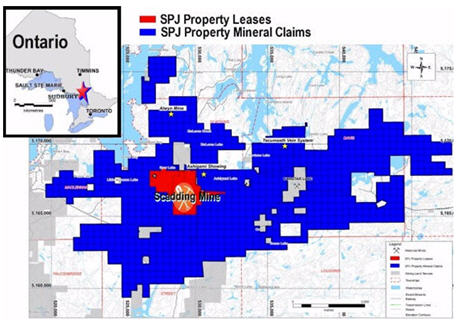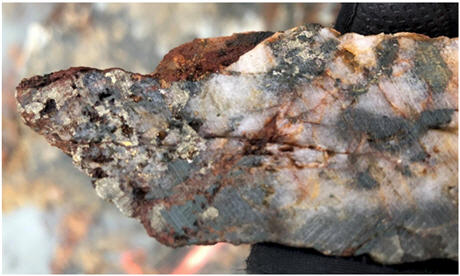Macdonald Mines Exploration Ltd. (TSX-V: BMK) (US Listing: MCDMF) (Frankfurt: 3M72) is encountering spectacular high-grade gold intercepts on stackings of thick gold zones using a predictive model at its 100%-owned 17,720 hectares SPJ Project, located ~33km SE of Sudbury, Ontario Canada. So impressive is this growing IOCG-style (gold dominant) project that well-known
precious metal investor Eric Sprott has taken a strategic position in BMK.V this October-2019.
MacDonald Mines is the subject of a Mining MarketWatch Journal review, the full review may be viewed at
https://miningmarketwatch.net/bmk.htm online.
The potential for a near-term high-grade shallow open-pitting production scenario (followed by underground) is increasingly developing off the North Pit of the historic Scadding Mine as MacDonald Mines builds intrinsic value with each new drill hole, and with only 5% of this land package having been explored to date there is also the possibility to see many more discoveries, especially since IOCG-style mineralized success often occurs in clusters.
 Fig.1 Location map (above)
Fig.1 Location map (above) - SPJ Project has year-long road access, is close to infrastructure & labour force.
"SPJ" stands for the assemblage of the Scadding, Powerline, and Jovan properties. MacDonald Mines Exploration recently assembled this brownfield land package and only began drilling this August-2019, expanding off the known high-grade mineralization next to the historic
Scadding Mine (which is located on the property with an active mining permit in place), a
past-producer in the 1980's of 144,000 tons of ore from open-pit at a grade of 7.43 g/t gold and 0.9% copper. The
Norstar Mine, located within 500 metres of the Jovan Property,
produced 63,000 tons of ore at a grade of 7.2 g/t gold and 0.9% copper (OFR 5771). Grab samples from the Norstar waste pile also contain
0.065 to 0.3% cobalt (a desirable and apparently viable companion-kicker if that deposit was mined today).
Headline grades of recent Gold intercepts in the Scadding Deposit from BMK.V's 2019 drilling campaign on SPJ Property:
October 22, 2019:
MacDonald Mines Hits Three High-Grade Gold Zones with 21.66 g/t Gold over 1.64 m including 40.6 g/t Gold over .87 m.
October 15, 2019:
MacDonald Mines Drills 11.10 g/t Gold over 6.14 m at its SPJ Property.
October 7, 2019:
MacDonald Mines Drills 14.04 g/t Gold over 4.21 m at its SPJ Property.
September 26, 2019:
MacDonald Mines Intersects High-Grade Gold in the Scadding Deposit – Drills 52 g/t Gold over 12 m.
To date BMK.V has reported 5 holes from its 2019 drilling campaign, and has other drill core in the lab with results pending. The Company is cashed-up to continue drilling, able to drill year round, and
investors can look forward to a continued stream of news. Some of the drill core currently in the lab looks spectacular with holes having intersected
multiple zones of iron-rich chlorite with visible gold in the core (note: iron-rich chlorite is what holds the high-grade gold mineralization on this IOCG-style deposit, it is the equivalent of finding a quartz vein in say Timmins), and others (results pending) having intersected hydrothermal breccia zone(s) containing iron-rich chlorite that has been associated with impressive gold mineralization in holes holes 001 through 005. (A summary, with insight, of holes with results pending is provided in a recent
Company Exploration Update).
BMK.V's technical team has been able to find what past operators struggled with; the team has found the main direction of continuity of zones of high-grade mineralization. This has enabled them to develop a predictive model that is yielding quality intercepts, and in time should lead to a meaningful resource estimate.
The Company's 2019 drill program has traced multiple zones of high-grade mineralization in the North Pit area over 100 metres along strike and down dip over 150 metres. There appears large upside share price appreciation in store for shareholders as drilling continues; the main structures that control mineralization are oriented North-South with a corridor width at least 500 m wide, the strike length can be traced at least over 500 m and theorized to be going much further -- possibly 2+ km (Note: On November 13, 2019 the Company announced grab samples yielding
anomalous cobalt, copper, nickel and gold values extending on strike 3.5 km NE of the Scadding Mine in the northern extension of the associated uranium anomaly – further confirming the enormous potential).
 Figure 2. (above) Interpretation of the geometry and surface view of the zones intersected in MacDonald Mines program on SPJ Property.
Figure 2. (above) Interpretation of the geometry and surface view of the zones intersected in MacDonald Mines program on SPJ Property.
So far the drilling program has been able to support continuity between high-grade intersections. The gold dominant zones of mineralization (seen in red above) are coalescing in the area of the historic Scadding Mine North Pit. The diabase dyke (seen in green) is a late geological event that crosscuts the zones of mineralization and possibly does some faulting and offsetting. There is a stack of high grade zones. The location of the drill collars are seen in the image above off to the right of the mineralized zone as the plain of the zones is dipping to the east, BMK.V optimizes intersects by drilling at ~245 degrees (average) in this area.
MacDonald Mines current exploration program
The primary objective of MacDonald Mines’ current exploration program is to demonstrate that a sizeable deposit exists on the SPJ Project. The program will be realized in 2 phases:
Phase 1 – Understand the attributes of the Scadding Deposit’s high-grade gold mineralization
- Evaluate drilling completed in the North and Central Zones of the Scadding Deposit.
- Continue the 2019 drilling program to explore the extension of the high-grade gold zones of the South, E-W and newly discovered zones of the Scadding Deposit.
- Expand the prospecting program to cover areas surrounding the Scadding Deposit.
- Continue a trenching program to mechanically strip areas where the Company’s recent compilation of historic data, uncovered potential zones of chlorite and magnetite alteration that were never drilled before. These zones, located outside the known footprint of the Scadding Deposit, have the potential to expand the mineralized zone.
Phase 2 – Find/expand the high-grade gold mineralization in the Scadding Deposit
- Conduct a geophysical survey that is optimized to detect mineral assemblages associated with polymetallic gold mineralization in the Scadding Deposit and in other prospective areas of the Project.
- Initiate an exploration drilling program to extend the 5 zones of the Deposit and the potential discoveries identified with the geophysical survey and geological modelling.
Latest exploration update:
On November 6, 2019 MacDonald Mines provided an exploration update in a news release entitled "
MacDonald Mines Completes 15 Drill Holes and Identifies Multiple High-Grade Gold Structures in the Scadding Deposit"; the Company announced that it has completed 15 drill holes and one trench to date in the Scadding Deposit and provided a summary and analysis of its on-going exploration program at the Company’s SPJ Property.
In the release the Company's President and CEO, Quentin Yarie, provided the following synopsis;
“The first five holes of our on-going drill program indicate that significant high-grade gold exists in the Scadding Deposit. The gold mineralization is controlled by a series of structures that are wider and of higher-grade than previously reported. More importantly, our results also show that there is continuity of these gold bearing structures. The two mineralized structures in the North Pit area - the Bristol and Monaco structures, remain open in all directions and they have been followed over 100 metres along strike and down dip over 150 metres. With the data gathered so far we are building a predictive geological model that is guiding our selection of drill targets as we continue to expand the mineralization of the SPJ Property.”
Mechanized stripping program at the Scadding Deposit
Following the positive results obtained in grab samples located in the potential extensions of the Scadding Deposit (October 1, 2019 news release), MacDonald’s mechanized stripping program uncovered a significant zone of chlorite alteration centered on a N-S structure named the Villeneuve Structure...
 Figure 3. (above) Villeneuve Structure revealed from MacDonald Mines' mechanized stripping program on the Scadding Deposit.
Figure 3. (above) Villeneuve Structure revealed from MacDonald Mines' mechanized stripping program on the Scadding Deposit.
Multiple indicators of gold mineralization were observed in the broad zone of chlorite alteration exposed on the Villeneuve trench. Channel samples were observed to contain pervasive disseminations of pyrite with minor chalcopyrite in the chlorite and a sample contained specks of visible gold...
 Figure 4. (above) Visible gold in Villeneuve channel sample
Figure 4. (above) Visible gold in Villeneuve channel sample (The photo is of a selected interval that is not necessarily representative of the mineralization hosted on the property).
The Villeneuve showing is located approximately 50 metres east of the E-W Pit of the Scadding Deposit and indicates that the broader N-S structural corridor that is associated with gold mineralization in the Scadding Deposit extends over 500 metres laterally in an east-west orientation.
The following URLs have been identified for further DD on MacDonald Mines:
Company website:
https://macdonaldmines.com
SEDAR:
URL
Recent Mining Journal Review:
https://miningmarketwatch.net/bmk.htm
##
James O’Rourke
James is a freelance information services professional for various media relation firms and financial publications. He monitors and invests in the resource, technology, consumer staples, healthcare, agriculture, financial, energy, utilities, and biotechnology/pharmaceutical sectors.
***
Legal Notice / Disclaimer
This document is not and should not be construed as an offer to sell or the solicitation of an offer to purchase or subscribe for any investment. The author has based this document on information obtained from sources he believes to be reliable but which has not been independently verified. The author makes no guarantee, representation or warranty and accepts no responsibility or liability as to its accuracy or completeness. Expressions of opinion are those of the author only and are subject to change without notice. The author assumes no warranty, liability or guarantee for the current relevance, correctness or completeness of any information provided within this Report and will not be held liable for the consequence of reliance upon any opinion or statement contained herein or any omission. Technical mining terms used by the writer may be used/expressed in simplified layman terms and should not be relied upon as appropriate for making investment decisions unless the reader contacts the company directly for independent verification. The author assumes no liability for any direct or indirect loss or damage or, in particular, for lost profit, which you may incur as a result of the use and existence of the information provided within this Report.